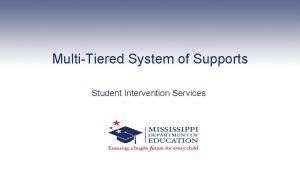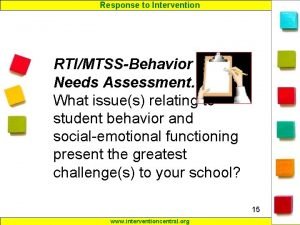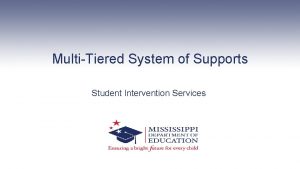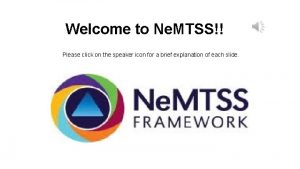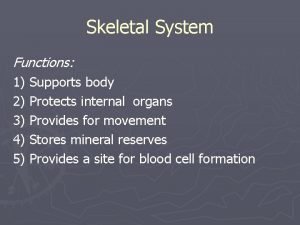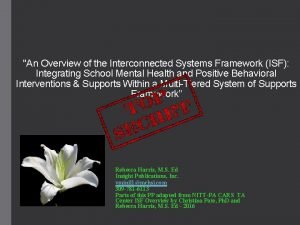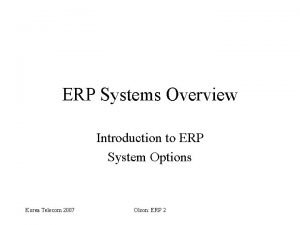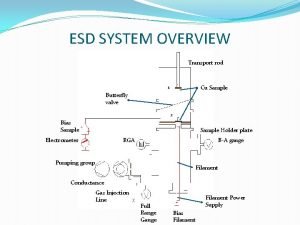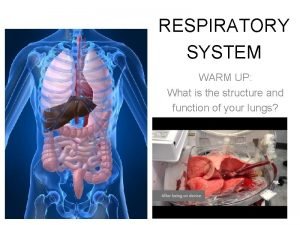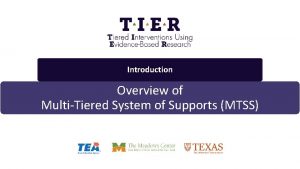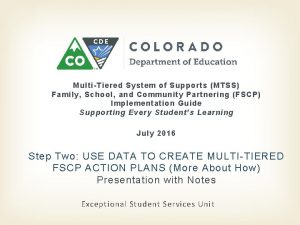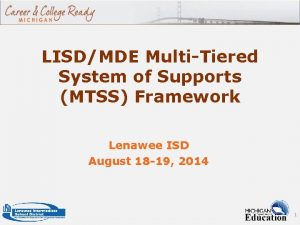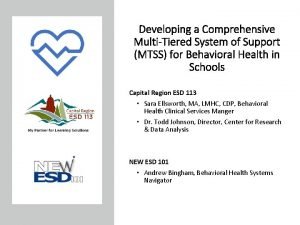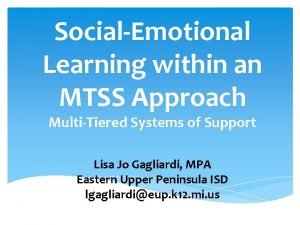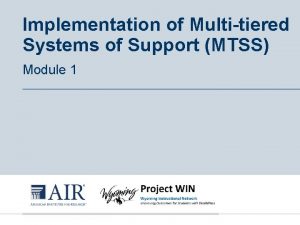Overview of MultiTiered System of Supports MTSS Para































- Slides: 31

Overview of Multi-Tiered System of Supports (MTSS) Para Conference August 2017 Angela Christenson, Psy. D. , NCSP and Kaitlin O’Shea, Ed. S. 1

Essential Outcomes ● Purpose of Response to Intervention (RTI)/Multi‐Tiered System of Supports (MTSS) ● Key Components ● Tiers ○ Building‐Specific Supports 2

Progress Bar Reflection 0% 100% 3

4

5

6

Multi-Tiered Systems of Support (MTSS) ● MTSS integrates assessment & intervention within a multi‐level prevention system to maximize student achievement and reduce behavior problems. Schools use data ■ to identify students at risk for poor learning outcomes, ■ monitor student progress, ■ provide evidence‐based interventions and adjust the intensity and nature of those interventions depending on a student’s responsiveness, ■ and identify students with learning disabilities or other disabilities. 7

MTSS 4 Essential Components of a MTSS framework: 1. 2. 3. 4. Multi‐level prevention system Screening Progress monitoring Data‐based decision‐making 8

MTSS At all levels, attention should be on fidelity of implementation and evidence-based tools, with consideration for cultural and linguistic responsiveness and recognition of student strengths. 9

Component #1: Multi-Level Prevention System ● The multi‐level prevention system also referred to as the multi‐tiered system of support (MTSS) includes three levels/tiers of intensity or prevention. ○ Primary prevention level includes high quality core instruction (also known as TIER 1). ○ Secondary level includes evidence‐based intervention(s) of moderate intensity usually delivered in small groups (also known as TIER 2). ○ Tertiary prevention level includes individualized intervention(s) of increased intensity for students who show minimal response to secondary prevention (also known as TIER 3). 10

Multi-Tiered Systems of Support ●Think‐Pair‐Share! ○ How does MTSS look in your building? Can you think of examples of supports at each of the different tiers? 11

Component #2: Universal Screening ● Screening is conducted to identify or predict students who may be at risk for poor learning outcomes and determine instructional support. ● Universal screening assessments are typically brief, conducted with all students at a grade level, and followed by additional diagnostic assessments and/or progress monitoring ○ At SCRED we use General Outcome Measures (GOMS) in reading and math (e. g. , MAP, FASTbridge) 12

How to Interpret Colors 99 to 75% chance 74 -26% chance 25 to 1% chance 13

How to Interpret Colors 99 to 75% chance 74 -26% chance Target score: the student with this score has a 75% chance of passing the MCA 25 to 1% chance 14

How to Interpret Colors 90% of the students with scores in the green will go on to pass the MCA 99 to 75% chance 50% of students in yellow will pass 74 -26% chance only 10% of students in red will pass 25 to 1% chance Target score: the student with this score has a 75% chance of passing the MCA 15

How to Interpret Colors When figuring out the number or percentage of students who will pass: add 90% of green + 50% of yellow + 10% of red 90% of the students with scores in the green will go on to pass the MCA 99 to 75% chance 50% of students in yellow will pass 74 -26% chance only 10% of students in red will pass 25 to 1% chance Target score: the student with this score has a 75% chance of passing the MCA 16

How to Interpret Colors When figuring out the number or percentage of students who will pass: add 90% of green + 50% of yellow + 10% of red 90% of the students with scores in the green will go on to pass the MCA Goal 99 to 75% chance 50% of students in yellow will pass 74 -26% chance only 10% of students in red will pass 25 to 1% chance Target score: the student with this score has a 75% chance of passing the MCA 80% of students scoring in green 15% of students in yellow 5% of students in red 17

Selecting Students for Intervention ●Use multiple pieces of data ●Limit to how many students you can serve ○ If number of students at‐risk is large, then you have a core instruction issue. Need to address through core instruction. ●Examine percentile data for possible special education ‐ share with problem solving team 18

Progress Bar Reflection 0% 100% 19

Component #3: Progress Monitoring ● Progress monitoring is used to: ○ Assess students’ academic performance, ○ Quantify a student rate of improvement or responsiveness to instruction, and ○ Evaluate the effectiveness of instruction. ■ At SCRED, we use Curriculum Based Measurements from AIMsweb and FAST (e. g. , ORF, MCAP). ● We progress monitor at‐risk students to ensure instructional support is working. 20

How to Use and Interpret PM Data 21

Progress Monitoring Graphs ●Reviewed frequently ●Decisions: ○ student’s scores are at or above goal line: keep instructional plan ○ student’s scores are not at or above goal line: bring to team for consideration 22

Component #4: Data-Based Decision Making ● Data analysis and decision making occur at all levels of RTI implementation and all levels of instruction. ○ Building level teams (GLTs, PSTs, and IEP Teams) use screening and progress monitoring data to make decisions ■ about instruction, ■ movement within the multi‐tier/level prevention system, ■ and special education disability identification (in accordance with state law). ● Data are also used for systems level analyses and program evaluation. 23

Overview of MTSS ●What is RTI and what are the essential components that must be present? 24

Special Education ●Think‐Pair‐Share! ○ How does Special Education fit within an MTSS Framework? 25

How Does It All Fit Together? 26

27

28

Multi-tiered Systems of Support ●Think‐Pair‐Share! ○ How does your role as a paraprofessional fit within an MTSS Framework? 29

MTSS 30

Progress Bar Reflection 0% 100% 31
 Mtss and udl
Mtss and udl Christy berger
Christy berger Mtss-b
Mtss-b Mde mtss documentation packet
Mde mtss documentation packet Mtss needs assessment
Mtss needs assessment Mtss documentation packet
Mtss documentation packet Benefits of mtss
Benefits of mtss Mtss
Mtss Mtss nebraska
Mtss nebraska Trazabilidad mtss
Trazabilidad mtss Mtss infographic
Mtss infographic Idoe science of happiness
Idoe science of happiness What system supports the body
What system supports the body Multi tiered system of supports
Multi tiered system of supports Erp system introduction
Erp system introduction Content management system overview
Content management system overview What is computerised accounting system
What is computerised accounting system Ductus parotideus
Ductus parotideus Crtd in sap
Crtd in sap Operating system overview
Operating system overview Use case diagram for fitness center
Use case diagram for fitness center Duodenum
Duodenum Computer memory system overview
Computer memory system overview Computer memory system overview
Computer memory system overview British school system presentation
British school system presentation Chapter 2 an overview of the financial system
Chapter 2 an overview of the financial system British school system overview
British school system overview System analysis
System analysis System design overview
System design overview System overview sample
System overview sample Lpi
Lpi 3 lobes lung
3 lobes lung



